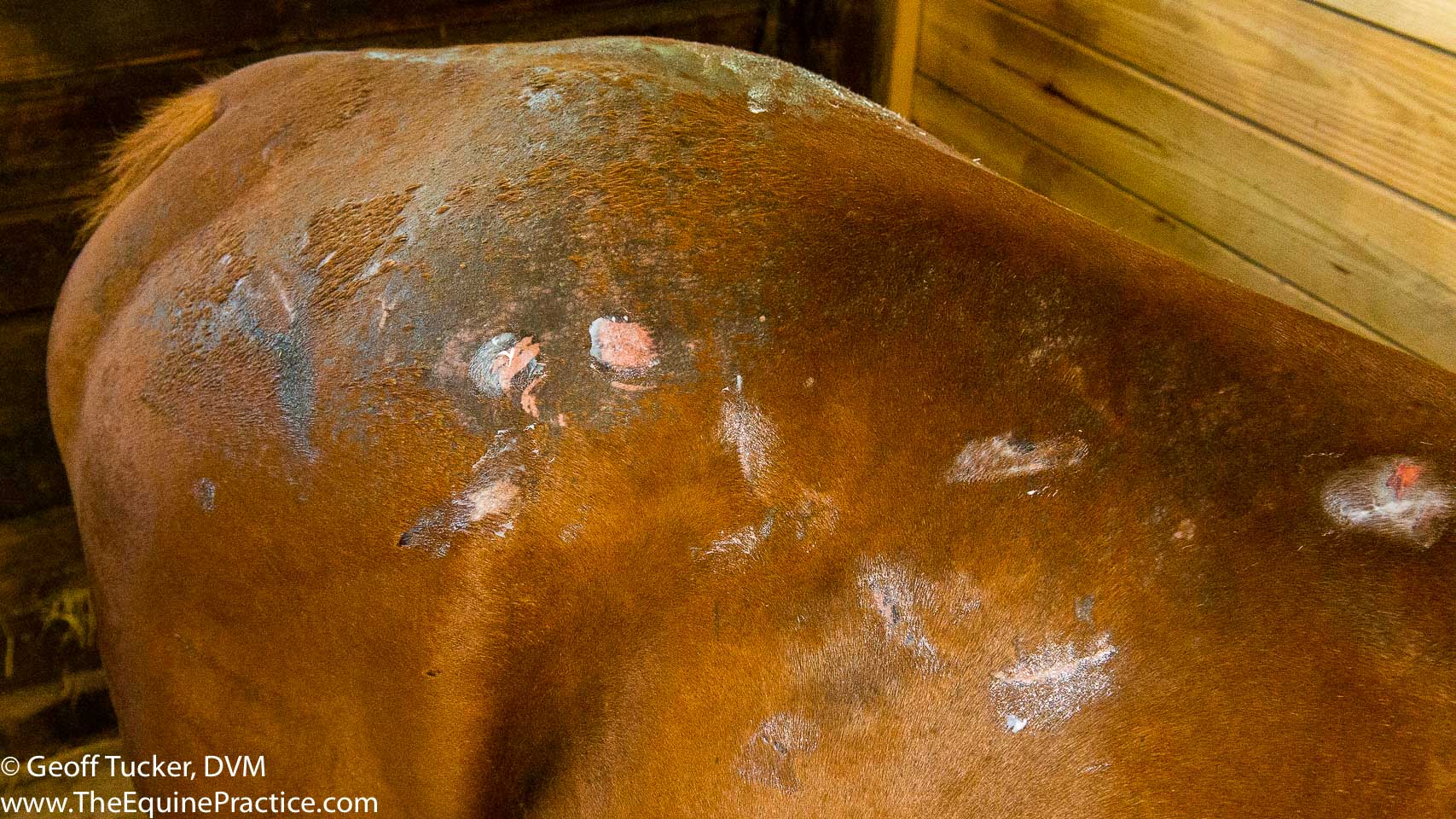Rain Rot: A Quick Guide for Horse Owners

Rain rot, also known as rain scald or dermatophilosis, is a skin condition that affects horses, causing discomfort and, if left untreated, potential complications. This bacterial infection is triggered by prolonged exposure to moisture, making it a common issue for horse owners during the wetter months. Understanding the causes, symptoms, and treatment options is essential for ensuring the well-being of your equine companions.
Understanding the Cause

Rain rot is primarily caused by the bacteria Dermatophilus congolensis. This bacteria normally exists on the horse’s skin without causing any issues. However, when the skin’s natural defenses are weakened, usually due to prolonged wetness, the bacteria can multiply and lead to an infection.
The wet conditions provide an ideal environment for the bacteria to thrive. When a horse’s coat remains damp for extended periods, especially during cooler months, the skin becomes vulnerable. This vulnerability is often exacerbated by factors such as poor grooming practices, insect bites, or other skin irritations, creating an entry point for the bacteria.
Recognizing the Symptoms

Identifying rain rot early is crucial for effective treatment. The condition typically presents as small, raised bumps or scabs along the horse’s back, neck, and shoulders. These scabs are often tightly clustered and may have a matted appearance. As the condition progresses, the scabs can become larger and more painful for the horse, often leading to patchy hair loss.
In some cases, the affected areas may ooze a clear or yellowish fluid, indicating an active infection. Horses with rain rot may also display signs of discomfort, such as rubbing against objects or constant tail switching. It’s important to note that rain rot can occur in different stages, from mild to severe, and may present differently in each horse.
Treatment and Management
The primary goal of treatment is to manage the moisture levels on the horse’s skin and provide relief from the bacterial infection. Here are some steps horse owners can take:
Drying Routine: Establish a rigorous drying routine, especially after rain or heavy fog. Use a sweat scraper to remove excess moisture and then employ a soft towel to gently dry the horse’s coat. Focus on areas prone to rain rot, such as the back, neck, and withers.
Grooming Practices: Implement a thorough grooming regimen to remove scabs and dead hair. Be gentle to avoid causing further irritation or pain. Disinfect all grooming tools after use to prevent cross-contamination.
Topical Treatments: Consult with a veterinarian for appropriate topical treatments. These may include antibacterial shampoos, sprays, or ointments specifically designed for rain rot. Follow the recommended application frequency and duration.
Nutritional Support: Ensure the horse’s diet is well-balanced and provides the necessary nutrients for skin health. Consider adding supplements rich in omega-3 fatty acids, which can promote skin healing and overall immunity.
Environmental Management: Take steps to reduce the horse’s exposure to wet conditions. Provide adequate shelter, especially during rainy periods, and ensure the horse’s living area is well-drained and clean.
Proactive Measures
Preventing rain rot is always preferable to treating it. Here are some proactive measures horse owners can take:
Regular Grooming: Establish a consistent grooming routine, even during dry periods. This helps identify any early signs of skin issues and keeps the horse’s coat healthy.
Moisture Control: Use waterproof blankets or rugs during wet weather to keep the horse’s coat dry. Ensure the blankets fit properly and are removed regularly for cleaning and drying.
Insect Control: Implement effective insect control measures to minimize bites and irritation. This can include the use of insect repellents, fly sheets, and regular stall cleaning to eliminate breeding grounds.
Nutritional Supplements: Consider adding nutritional supplements rich in biotin and zinc, which are essential for skin and coat health. These supplements can strengthen the horse’s natural defenses against skin infections.
Regular Veterinary Check-Ups: Schedule regular veterinary check-ups to monitor the horse’s overall health, including skin condition. Early detection and treatment of any skin issues can prevent more severe complications.
When to Seek Veterinary Advice

While mild cases of rain rot can often be managed with at-home care, it’s essential to seek veterinary advice in certain situations:
- If the horse shows signs of pain or discomfort that cannot be managed with gentle care.
- When the infection spreads rapidly or covers a large area of the horse’s body.
- If the horse develops a fever or displays signs of systemic illness.
- When at-home treatments do not improve the condition within a reasonable timeframe.
Your veterinarian can provide a more comprehensive diagnosis and prescribe appropriate medications if needed.
Conclusion
Rain rot is a manageable skin condition, but it requires vigilance and proactive care from horse owners. By understanding the causes, recognizing the symptoms early, and implementing appropriate treatment and management strategies, horse owners can ensure their equine companions stay healthy and comfortable, even during the wettest of seasons.
Remember, a little extra care and attention can go a long way in preventing and managing rain rot, promoting the overall well-being of your horses.



